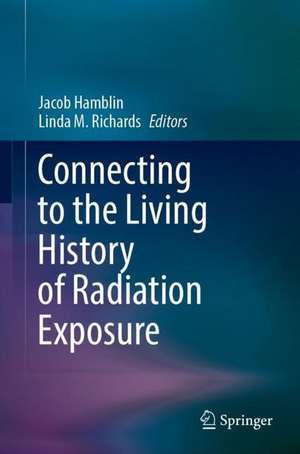Connecting to the Living History of Radiation Exposure
Editat de Jacob Hamblin, Linda M. Richardsen Limba Engleză Hardback – 15 noi 2022
This book highlights the multiple ways of telling stories of radiation exposure; they include stories about Japan, Australia, the United States, the Canadian Arctic, and more, and they probe the framing of major incidents such as Three Mile Island, Chernobyl, and Fukushima. All the chapters in this book are written by authors who participated in our work at Oregon State University and have benefited from hearing not only from scientists but also from those whose lives were directly affected by the history of radiation exposure. The question ‘What is at stake when researching and narrating the histories of radiation exposure?’ is discussed, but the book does not reinforce existing frameworks, such as legal decisions or government policies, but rather highlights what narrative framings accomplish and commit by scrutinizing them with rigorous research, varied approaches, and, above all, listening to those whose lives were most affected by exposure.
Previously published in Journal of the History of Biology Volume 54, issue 1, April 2021
Previously published in Journal of the History of Biology Volume 54, issue 1, April 2021
Preț: 696.24 lei
Preț vechi: 819.11 lei
-15% Nou
Puncte Express: 1044
Preț estimativ în valută:
133.23€ • 142.46$ • 111.08£
133.23€ • 142.46$ • 111.08£
Carte tipărită la comandă
Livrare economică 17 aprilie-01 mai
Preluare comenzi: 021 569.72.76
Specificații
ISBN-13: 9783031187575
ISBN-10: 3031187571
Pagini: 145
Ilustrații: V, 145 p. 1 illus.
Dimensiuni: 155 x 235 mm
Greutate: 0.4 kg
Ediția:1st ed. 2022
Editura: Springer Nature Switzerland
Colecția Springer
Locul publicării:Cham, Switzerland
ISBN-10: 3031187571
Pagini: 145
Ilustrații: V, 145 p. 1 illus.
Dimensiuni: 155 x 235 mm
Greutate: 0.4 kg
Ediția:1st ed. 2022
Editura: Springer Nature Switzerland
Colecția Springer
Locul publicării:Cham, Switzerland
Cuprins
Connecting to the Living History of Radiation Exposure.- The Cosmology of Evidence: Suffering, Science, and Biological Witness After Three Mile Island.- Disproportionate Impacts of Radiation Exposure on Women, Children, and Pregnancy: Taking Back our Narrative.- Locating the Boundaries of the Nuclear North: Arctic Biology, Contaminated Caribou, and the Problem of the Threshold.- The Visual Politics of Maralinga: Experiences, (Re)presentations, and Vulnerabilities.- Let Chromosomes Speak: The Cytogenetics Project at the Atomic Bomb Casualty Commission (ABCC).- Embracing Mystery: Radiation Risks and Popular Science Writing in the Early Cold War.- Erika Lorraine Milam, Creatures of Cain: The Hunt for Human Nature in Cold War America, (Princeton: Princeton University Press, 2019), 408 pp., 33 b/w illus., $29.95 Cloth, ISBN: 9780691181882.
Notă biografică
Jacob Darwin Hamblin writes about the history and politics of science, technology, and environmental issues. His writing has appeared in the New York Times, Science, Salon, and The American Scientist, and his peer-reviewed essays have appeared in Isis, Diplomatic History, Environmental History, Technology and Culture, and many other academic journals. He has published dozens of book reviews.
Hamblin's most recent book is The Wretched Atom: America's Global Gamble with Peaceful Nuclear Technology. It focuses on the promotion of nuclear “solutions,” especially in the developing world, from 1945 to the present. This history is drawn from archival work at the International Atomic Energy Agency and many other sources. It draws attention to unfamiliar connections among environmental rhetoric, nuclear technology, petroleum interests, and arms deals.
Arming Mother Nature: The Birth of Catastrophic Environmentalism, the winner of two major book prizes, challenges us to consider how much our views of global environmental change come from collaboration between scientists and the military as they planned to fight, and to survive, a third world war. His previous book, Poison in the Well: Radioactive Waste in the Oceans at the Dawn of the Nuclear Age, was the first international history of one of the least-understood environmental controversies of the twentieth century. An earlier book, Oceanographers and the Cold War, explores the reasons for the explosive growth of the marine sciences after World War II.
Hamblin created H-Environment Roundtable Reviews and edited more than thirty of them from 2010-2015. He commissioned and edited essay reviews for Historical Studies in the Natural Sciences from 2011-2015, and has served as advisory editor for that journal continuously since 2011. He was advisory editor of Isis from 2009-2011, and was on the advisory board of Environmental Historyfrom 2013-2018. He has chaired the selection committees for the George Perkins Marsh Prize for best book in environmental history, Phil Pauly Prize for best first book in the history of science in North America, and the Usher Prize for best essay in Technology in Culture. He has directed three different graduate programs at Oregon State University, and currently he directs the university’s Environmental Arts and Humanities Initiative.
Linda M. Richards
Textul de pe ultima copertă
This book highlights the multiple ways of telling stories of radiation exposure; they include stories about Japan, Australia, the United States, the Canadian Arctic, and more, and they probe the framing of major incidents such as Three Mile Island, Chernobyl, and Fukushima. All the chapters in this book are written by authors who participated in our work at Oregon State University and have benefited from hearing not only from scientists but also from those whose lives were directly affected by the history of radiation exposure. The question ‘What is at stake when researching and narrating the histories of radiation exposure?’ is discussed, but the book does not reinforce existing frameworks, such as legal decisions or government policies, but rather highlights what narrative framings accomplish and commit by scrutinizing them with rigorous research, varied approaches, and, above all, listening to those whose lives were most affected by exposure.
Caracteristici
Highlights the multiple ways of telling stories of radiation exposure Listens to those whose lives were directly affected by the history of radiation exposure Shows what narrative framings accomplish and commit
